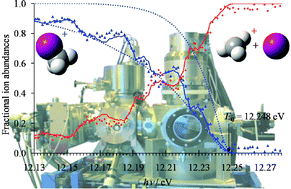The dissociative photoionization onset energy of the CH3I → CH3+ + I reaction was studied at the vacuum ultraviolet (VUV) beamline of the Swiss Light Source (SLS) using a new imaging photoelectron photoion coincidence (iPEPICO) apparatus operating with a photon resolution of 2 meV and a threshold electron kinetic energy resolution of about 1 meV. Three previous attempts at establishing this value accurately, namely a pulsed field ionization (PFI)-PEPICO measurement, ab initio calculations and a mass-analyzed threshold ionization (MATI) experiment, in which the onset energy was bracketed by state-selected excitation to vibrationally excited 2A1 A states of the parent ion, have yielded contradictory results. It is shown that dimers and adducts formed in the supersonic molecular beam affected the PFI-PEPICO onset energy. The room temperature iPEPICO experiment yields an accurate 0 K onset of 12.248 ± 0.003 eV, from which we derive a ΔfHo298 K(CH3I) = 15.23 ± 0.3 kJ mol−1, and the C–I bond energy in CH3I is 232.4 ± 0.4 kJ mol−1. The room temperature breakdown diagram shows a fine structure that corresponds to the threshold photoelectron spectrum (TPES) of the A state. Low internal energy neutrals seem to be preferentially ionized in the A state when compared with the X state, and A state peaks in the TPES are Stark-shifted as a function of the DC field, whereas the dissociative photoionization of X state ions is not affected. This suggests that there are different competing mechanisms at play to produce ions in the A state vs. ions in the X state. The competition between field ionization and autoionization in CH3I is compared with that in Ar, N2 and in the H-atom loss energy region in CH4+. The binding energies of the neutral and ionic Ar–CH3I clusters were found to be 26 and 66 meV, respectively.

You have access to this article
 Please wait while we load your content...
Something went wrong. Try again?
Please wait while we load your content...
Something went wrong. Try again?


 Please wait while we load your content...
Please wait while we load your content...